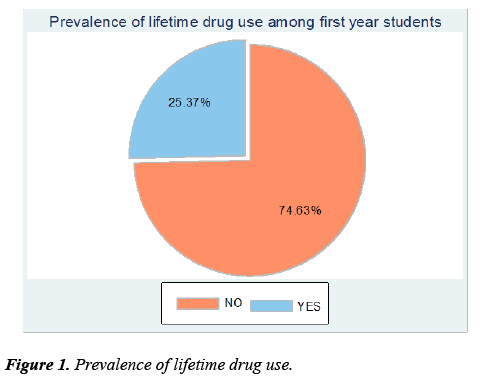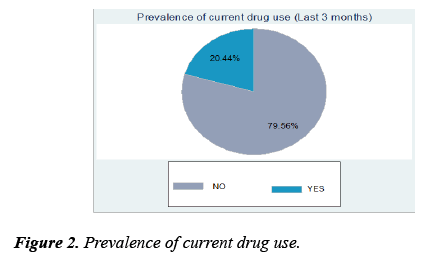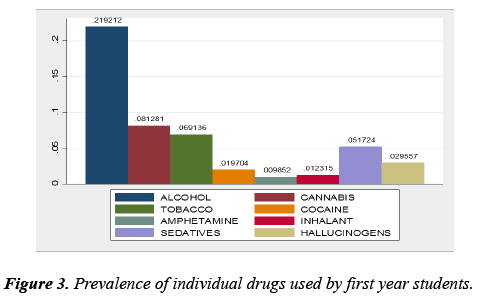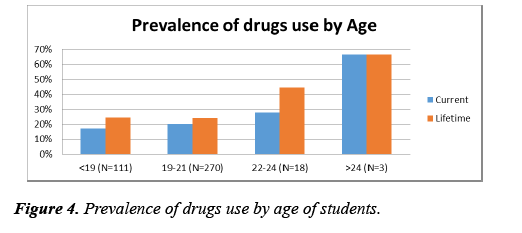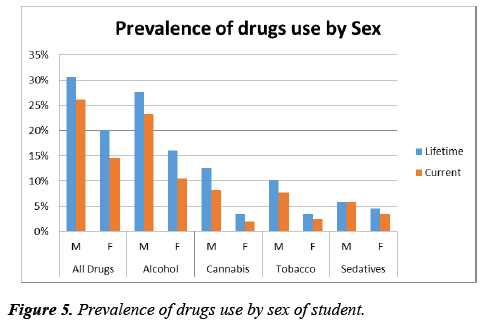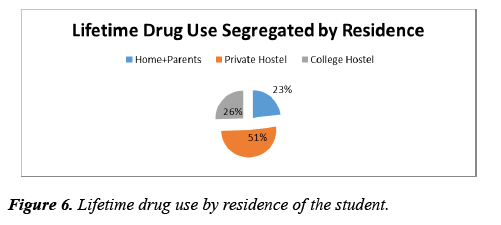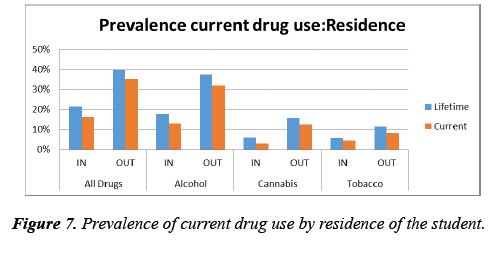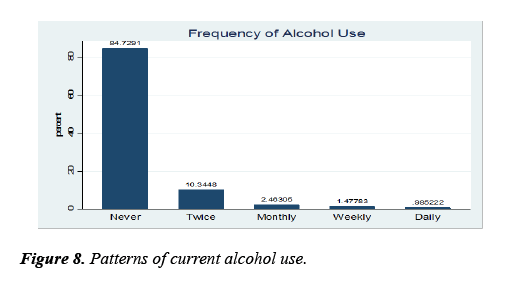Research Article - Journal of Psychology and Cognition (2019) Volume 4, Issue 2
Prevalence and patterns of substance use among first year students in a Public University in Kenya.
Catherine Mawia Musyoka*, Anna Mbwayo, Muthoni MathaiDepartment of Psychiatry, University of Nairobi, 30197, Nairobi, Kenya.
- *Corresponding Author:
- Yavisheva TM
Department of Psychiatry
University of Nairobi, 30197
Nairobi-00100, Kenya
Tel: 254721723514
E-mail: camulundu2011@gmail.com
Accepted Date: January 30, 2017
Citation: Yavisheva TM, Shcherbakov SD. Carcinogenesis from the viewpoint of the work of the morphofunctional zones and aging. J Aging Geriatr Psychiatry. 2017;1(2):1-10
Abstract
Background: Use of alcohol and psychoactive substances has continued to rise globally. The age at which children start experimenting with alcohol and substances of abuse has also dropped drastically over the years. This use of alcohol and substances of abuse during adolescence and early adulthood is a serious public health problem in many developing countries such as Kenya. It leads to considerable harm to the individuals, families and societies as a whole. This study determines the prevalence and patterns of alcohol and substance use at the entry to the University of Nairobi which can be considered as a good representation of the drug use situation in Kenyan universities and a microcosm of the national youths’ drug use outlook. It will help the universities’ management to institute appropriate intervention, for prevention and management of alcohol and substance use among its students. It will also help inform policies and interventions to reverse the rising tide of drug abuse amongst the youths.
Methods: A cross sectional study randomly sampled first year students (n=406;50.74% male) in two campuses of the University of Nairobi. Self-administered questionnaires were used to measure their knowledge, attitudes and use/abuse of psychoactive substances. The data obtained was analysed using inferential statistics and results were presented in a graphical form.
Results: 25.37% of the students had used a psychoactive substance in their lifetime. Alcohol was the most used drug having been consumed by 21.92% of the sampled students. Cannabis was consumed by 8.13%whereas tobacco was consumed by 6.91% of the students.
Conclusion: Majority (74.63%) of university students, have not used alcohol and psychoactive substances by the time they join the university. This is good news for the alcohol and drug abuse control program because it shows that the use prevalence is still low enough to be reversed. For the one-quarter who have experimented with psychoactive substances intervention strategies which to rehabilitate them should be instituted as strategies to prevent those who have not started use/abuse from starting are also put in place.
Keywords
Alcohol and drug use, Prevalence, Psychoactive substances, Substance use, University students.
Introduction
Alcohol and Substance use (ASU) among college students is an issue of global public health concern [1]. The age at which children start to experiment with alcohol and substances of abuse has dropped worldwide [2]. The use of psychoactive substance leads to considerable harm to the individuals, families and societies as a whole [3]. The earlier younger people begin to use of drugs, the more the vulnerable they become to experience both short term and long-term harmful effects. These effects include poor academic performance, accidents and injuries, criminal behaviour, poor social relations, sexual assault and risky sexual behaviour [4]. Therefore, prioritization of prevention activities among university students is important.
Programs for intervention on initiation and continued use of psychoactive substances is an integral part of many institutions of higher learning [5]. The strategies used include those aimed at universal prevention for those not yet using, selective prevention for those already experimenting with psychoactive substances and treatment of alcohol and drug use disorders for those suffering from harmful use [6]. The goal for universal prevention is to prevent the young people from initiating drug use behaviours, while selective prevention is aimed at those at risk of problematic drug use [6].
There are various barriers to early identification and interventions against alcohol and drug use/abuse among students. These include stigma associated with SUDs, inadequate skilled practitioners in adolescent substance use intervention, as well limited facilities for treatment of adolescents with substance use disorders [7]. This then, leads to missed opportunities in early identification, referral and linkage to care.
Objective
To determine the prevalence and patterns of alcohol and drugs use among freshmen and women at the University of Nairobi.
Methods
Study design
A cross sectional study of randomly sampled first time students joining the Kikuyu and Chiromo campuses of the University of Nairobi. Purposeful random sampling was done. 406 first year students aged between 17 and 25 years participated in the study between September and November 2018.
Inclusion and exclusion criteria
Inclusion criteria: Consenting freshly admitted first year students of Kikuyu and Chiromo campuses of the University of Nairobi.
Exclusion criteria: Students in other levels of study. Participants recruitment and data collection procedures
The researcher with the permission from the dean of studies office obtained the enrolment and class lists, of the various courses offered in the colleges of interest. Using statistical calculations, the desired sample was determined from every course offered, depending on the class enrolment.
Random.com software was used to identify the number to be sampled from a pre-determined class attendance list. Working with first-year class representatives, class schedules were determined.
The researcher approached the relevant lecturer and requested for 30 minutes’ class time to administer the questionnaire. Once this was granted the researcher and her assistants would go to the lecture room 30 minutes in advance of a lecture. The students would be approached while in class, the prechosen student would be identified, the study would be explained to them.
They were then requested for their written consent to participate in the study. Students who consented would complete an anonymous self-questionnaire which included socioeconomic characteristics (age, gender, marital status and residence).
If the student declined to participate or they were absent from the class on the day of data collection, the next student on the class list would be approached and requested for their consent and participation in the study.
This process was repeated until the desired sample size was achieved. Data collection was anonymous and confidential. Moreover, informed written consent was systematically obtained from students. Ethical approval for this study was granted by the School of Medicine graduate committee, University of Nairobi and the University of Nairobi and Kenyatta National Hospital ethical committee (UON/KNH) P98/02/2018.
The data collected was handled with confidentiality. All documents were protected by several levels of passwords. Descriptive and inferential statistics were used in data analysis (Table 1).
| Variables | Category | Number | % |
|---|---|---|---|
| Sex | Male | 206 | 50.74 |
| Female | 199 | 49.01 | |
| NR | 1 | 0.25 | |
| Age (years) | 17-19 | 260 | 64.04 |
| 20-22 | 134 | 33.00 | |
| 23-25 | 7 | 1.72 | |
| NR | 5 | 1.24 | |
| Faculty | Physical sci. | 115 | 28.57 |
| Mathematics | 46 | 11.33 | |
| Biological science | 19 | 4.68 | |
| Computing | 22 | 5.42 | |
| Education | 184 | 45.32 | |
| Architecture | 19 | 4.68 | |
| Year of Study | First | 403 | 99.26 |
| Second | 1 | 0.24 | |
| Third | 1 | 0.24 | |
| NR | 1 | 0.24 | |
| Mode of Study | Regular | 371 | 91.38 |
| Parallel | 33 | 8.13 | |
| NR | 2 | 0.50 | |
| Marital status | Single | 398 | 98.03 |
| Married | 2 | 0.49 | |
| Cohabiting Separated | 5 1 | 1.23 0.24 | |
| Residence | On Campus | 318 | 78.54 |
| Private Hostels | 25 | 6.17 | |
| Home | 47 | 11.60 | |
| Other | 15 | 3.70 |
Table 1. Social demographic characteristics of the respondents N 406.
Assessment of substance involvement
Assessment for substance involvement was done using the Assessment of Smoking and Substance Involvement Tool (ASSIST), a World Health Organization approved tool for assessment of drugs involvement among a wide range of populations. This tool identifies more than 10 different types of psychoactive substances including the Alcohol, Cannabis and Tobacco, which are the most commonly used drugs by student [8-10].
Alcohol Use Disorder Identification Tool (AUDIT) was also used to measure the patterns of alcohol use among the students. This tool is able to determine the prevalence of binge drinking as defined by the National Institute of Alcohol Abuse and Alcoholism (NIAAA), as five or more alcoholic drinks (four or more for women) on any one occasion and at least once a week [11].
Results
Baseline characteristics of the study population
406 study participants met the study criteria. 42.86% students were pursuing a degree in education. The rest were pursuing courses in the College Physical and Biological Sciences 57.14%. In terms of sex, the majority of participants 50.74% were males, while females were 49.01. 0.25% respondent did not indicate their sex. The mean age was 19.19212 (SD 0.0824212). The most common age of the respondents was 19 years (range: 17 to 25). Module 1 who are government sponsored students were 93.73%, while 5.78% were module II or privately sponsored students. Most of these students resided at university hostels 81.69%, while 5.06%, resided in private hostels. Those who resided their parents were 9.16%, while 4.10% resided in other places. On Marital status, 98.07% were single, 2.87% were in a relationship.
The overall prevalence of substance use among first year university of Nairobi students was 25.37% or (103) had used a psychoactive substance in their lifetime while 74.63 % or (303) had never experimented with a psychoactive substance (Figure 1).
Current use of psychoactive substances defined by use in the last 3 months prior to the study was reported by 20.44% or (83) of the respondents (Figure 2).
Alcohol was the most used drug having been consumed by 21.92% of the sampled students. Cannabis was consumed by 8.13% whereas tobacco was consumed by 6.91% of the students. In addition, 5.17% of the students had used experimented with sedatives in their lifetime. Use of cocaine was reported by 1.97% of the students. All the other groups of drugs listed had all been used by less than 1% of the students (Figure 3).
As pertains age of use, 24% of students between 17 and 21 years had ever used drugs, this figure rose to 44% among those aged 22 and 24 years who had ever used drugs. Those aged 25years and above had 67% used drugs in their lifetime (Figure 4).
In terms of sex, findings indicate that 31% of males have used a psychoactive drug in their lifetime, as compared to 26% of female students. When individual drugs are taken into consideration the trend is the same, with 23% of male students taking alcohol, as compared to 11% of female students who take alcohol. 8% of male students are currently taking cannabis as compared to 2% of female students who are currently taking cannabis. 6% male students are currently using sedatives as compared to 4% of female students taking the same (Figure 5).
Taking into consideration the area of residence and lifetime ever use of drugs, results show that 51% of students reside in private hostels, 26% reside at home with their parents, while 23% reside in university hostels (Figure 6).
As well, current individual drug use is related to area of residence shows that, 32% of students who currently use alcohol reside off campus, while 13% of current alcohol users reside in campus residence. 16% of current cannabis users reside off campus, while 3% reside in campus residence. Tobacco is used by 8% of off campus residents as compared to 4% in campus residence (Figure 7).
Patterns of drug use among current alcohol users show that 10% of the users do so occasionally, 2.4 % dink at least once a month, 1.47% takes alcohol every week and 1% drinks on a daily basis (Figure 8).
Discussion
The overall lifetime prevalence of drugs was found to be 25.37%. These findings are in agreement with other studies done elsewhere. A study done in the Association of South-East Asian Nations (ASEAN) found a varying prevalence of illicit drugs among university students of ranging from 0.2 % in Cambodia and 45.7% in Laos [3]. The study results also agree with findings of a study done in France where the prevalence of tobacco use among university students was reported at 23.2%, while alcohol consumption was at 20.1% [12].
These study findings however, differed with those of a prevalence study among medical students in Nigerian university that showed a lifetime use of mild stimulants 46.1%, alcohol 39.7% and tobacco (6%) [13].
The results of prevalence of drug use by age, suggest that the older the student, the more likely they are to use alcohol and other drugs. This result is agreeing with other studies which have indicated that drug use behaviour is highest at the age of 18 to 24 years. This is the age at which these young people pursue their university education [14]. A study done in Kenya, also indicated that university and secondary school students were among the leading categories of drug users in Kenya [15,16].
The findings of prevalence of drug use considered by sex, suggested that when compared to females, males were the leading users in all categories of drugs. These results are similar to those from other parts of the world which have indicated that males use drugs more than females [17,18].
The results indicate that over 50% of all students who had ever experimented with drugs in their lifetime, resided in private hostel, those who resided in were the second largest category, those who reside home with parents were found to have been least likely to use drugs. These findings support the belief that residing at home with parents is a protective factor against drug use for many young people. This study is in agreement with studies that found that living off campus posed the highest risk of alcohol use [19]. Private hostels in Kenya are unregulated, they have no strict rules regarding the use of alcohol and drugs in the premises and some are located in areas which have numerous drinking bars. Again, many people see private hostels as a rich source of customers for their many wares, including drugs. All these make students residing in these premises to be more vulnerable to drug use.
When current patterns of drug use are compared for all drugs, students who stay in university hostels consume less drugs than those living off campus residence. This underpins the need to have prevention interventions among university students target more of the off-campus residents. Most preventive interventions today are focused on the university facilities. This leaves out a vulnerable group in off campus residence, yet they need these interventions most.
The patterns of alcohol use found in the study also reveal that most students only used alcohol occasionally. This was most likely during the weekends when they socialize with their friends. This is of concern too because studies indicate that students who begin to use drugs early in their life, are most likely to suffer the negative consequences of drugs in later life [14]. There were 5% of students who reported use of alcohol on a regular basis, some even on a daily basis. These students are of great concern given that they are in their first year of University education; they are at a great risk to have the drugs alter the functioning of their brains and the entire body, poor academic outcomes, violence, criminal activities have been associated with drug use among college students [20,21].
The results of this study show that a significant percentage of youth use alcohol and other drugs of abuse even before they report to the university. Prevention interventions for substance use should start at the pre-university level. and should be intensified right from entry to university and throughout their studies.
Research in substance use disorders prevention and management has made significant progress by developing and testing different intervention strategies for youth [6]. However, the current models of delivering these intervention strategies, have challenges. For example, face to face interventions with the youth are not easy to implement, because of the stigma associated with substance use, as a result only 10-15% of adolescents receive the interventions they need for their substance use disorders [22]. Use of innovation and technology based interventions provides an avenue to deliver evidence based interventions to the use youth as compared to face to face programs [6]. University managements should explore all avenues to save students from drug use and its negative consequences.
Conclusions and Recommendations
Interventions for prevention and management of substance use should start early, preferably during high school and be intensified at university level. This will help mitigate against the global escalation of negative consequences of substance abuse witnessed in the universities. Drug prevention intervention strategies should also be focused on University students who reside in off campus residences as they reported the highest prevalence of substance use. Universities should also increase the available accommodation facilities for their students. This will make prevention intervention among college students earlier to implement, as well, residing in University hostels was reported to be a protective factor against drug use.
The large percentage of students, 74.63% who had never experimented with a psychoactive substance are a useful resource in the prevention programs, there is need therefore to train them to become peer mentors and role models to the ones who may be at risk of starting to use drugs.
Compliance with Ethical Standards
Disclosure of potential conflict of interest
The corresponding author is the program coordinator for Alcohol and Drug Abuse Prevention program at the University of Nairobi.
Author 2 and 3 declare that they have no conflict of interest.
The ethical approval
All procedures performed in studies involving human participants were in accordance with the ethical standards of the institutional and/or national research committee and with the 1964 Helsinki Declaration and its later amendments or comparable ethical standards.
Statement on the welfare of animals
This article does not contain any studies with animals performed by any of the authors.
Informed consent
Informed consent was obtained from all individual participants included in the study.
Funding
"This research was supported by the Consortium for Advanced Research Training in Africa (CARTA). CARTA is jointly led by the African Population and Health Research Center and the University of the Witwatersrand and funded by the Carnegie Corporation of New York (Grant No--B 8606.R02), Sida (Grant No:54100113), the DELTAS Africa Initiative (Grant No: 107768/Z/15/Z) and Deutscher Akademischer Austauschdienst (DAAD). The DELTAS Africa Initiative is an independent funding scheme of the African Academy of Sciences (AAS) ’ s Alliance for Accelerating Excellence in Science in Africa (AESA) and supported by the New Partnership for Africa ’ s Development Planning and Coordinating Agency (NEPAD Agency) with funding from the Wellcome Trust (UK) and the UK government. The statements made and views expressed are solely the responsibility of the Fellow".'
References
- https://www.unodc.org/wdr2016/
- Johnston LD, O’Malley PM, Bachman JG, et al. Monitoring the FUTURE: College Students & Adults Ages 19-55. Monitoring the Future. 2014; 2.
- Yi S, Peltzer K, Pengpid S, et al. Prevalence and associated factors of illicit drug use among university students in the association of southeast Asian nations (ASEAN). Subst Abuse Treat Prev Policy. 2017;12(1):1-7.
- Zufferey A, Michaud PA, Jeannin A, et al. Cumulative risk factors for adolescent alcohol misuse and its perceived consequences among 16 to 20-year-old adolescents in Switzerland. Preventive Medicine. 2007;45(2-3):233-39.
- Sundström C, Gajecki M, Johansson M, et al. Guided and unguided internet-based treatment for problematic alcohol use - A randomized controlled pilot trial. PLoS ONE. 2016;11(7) e0157817.
- Marsch LA, Borodovsky JT. Technology-based Interventions for Preventing and Treating Substance Use Among Youth. Child Adolesc Psychiatr Clin N Am. 2016;25(4)755-68.
- Das JK, Salam RA, Arshad A, et al. Interventions for Adolescent Substance Abuse: An Overview of Systematic Reviews. J Adolesc Health. 2016;59(2)S61-S75.
- Group WAW. The Alcohol, Smoking and Substance Involvement Screening Test (ASSIST): Development, reliability and feasibility. Addiction, 2002;97(9)1183-94.
- Humeniuk R, Ali R. Validation of the Alcohol, Smoking and Substance Involvement Screening Test (ASSIST) and Pilot Brief Intervention : A Technical Report of Phase II Findings of the WHO ASSIST Project. World Health Organization. 2006.
- World Health Organization. The ASSIST project - Alcohol, Smoking and Substance Involvement Screening Test. 2018.
- DeMartini KS, Fucito LM, O’Malley SS. Novel approaches to individual alcohol interventions for heavy drinking college students and young adults. Curr Addict Rep 2015;2(1)47-57.
- Tavolacci MP, Ladner J, Grigioni S, et al. Prevalence and association of perceived stress, substance use and behavioral addictions: a cross-sectional study among university students in France, 2009-2011. BMC Public Health. 2013;13(1):724.
- Makanjuola AB, Abiodun OA, Sajo S. Alcohol and psychoactive substance use among medical students of the university of Ilorin, Nigeria. European Scientific Journal. 2014;10(8): 69-83.
- Dhanookdhary AM, Gomez AM, Khan R, et al. Substance Use among University Students at the St Augustine Campus of The University of the West Indies. West Indian Med J. 2010; 59(6):641-9.
- NACADA. Rapid situation assessment of the status of drug and substance abuse. National Authority for the Campaign Against Alcohol and Drug Abuse. 2012.
- Ndegwa S, Munene A, Oladipo R. Factors Associated with Alcohol Use among University Students in a Kenyan University. African Journal of Clinical Psychology. 2017;1:102-17.
- Silva LVER, Malbergier A, Stempliuk V, et al. Factors associated with drug and alcohol use among university students. Revista de Saude Publica. 2006;40(2):280-88.
- Kassa A, Taddesse F, Yilma A. Prevalence and factors determining psychoactive substance (PAS) use among Hawassa University (HU) undergraduate students, Hawassa Ethiopia. BMC Public Health, 2014;14:1044.
- Benz MB, DiBello AM, Balestrieri SG, et al. Off-Campus Residence as a Risk Factor for Heavy Drinking Among College Students. Subst Use Misuse. 2017;52(9):1236-41.
- Tahtamouni LH, Mustafa NH, Alfaouri AA, et al. Prevalence and risk factors for anabolic-androgenic steroid abuse among Jordanian collegiate students and athletes. Eur J Public Health. 2008;18(6):661-65.
- White A, Hingson R. The Burden of Alcohol Use College Students. Alcohol Res. 2013;35(2):201-218.
- Cagande CC, Pradhan BK, Pumariega AJ. Treatment of adolescent substance use disorders. Adolesc Med State Art Rev. 2014;25(1):157-71.
